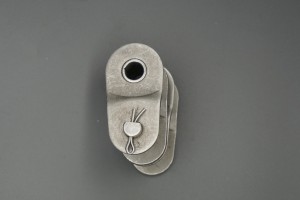Roller Chain Closed-Loop Links: Why an Even Number of Links is Preferable?
In industrial transmission systems, roller chains, as efficient and reliable power transmission devices, are widely used in a wide range of fields, including machinery manufacturing, agricultural equipment, and logistics. For buyers, selecting a roller chain with appropriate parameters directly impacts equipment operating efficiency, maintenance costs, and service life. While selecting the total number of links in a closed-loop chain may seem simple, it harbors crucial engineering logic. Industry consensus holds that an even number of links is preferred for roller chains. This conclusion isn’t arbitrary; it’s based on a comprehensive consideration of chain structural characteristics, transmission efficiency, and service life.
I. Basic Structure and Connection Principles of Roller Chains
To understand the core logic behind link selection, it’s first necessary to understand the basic structure of a roller chain. A standard roller chain consists of inner and outer plates, pins, bushings, and rollers. The pins and bushings coordinate to enable flexible rotation of adjacent links. When a chain forms a closed loop, connecting links are required to secure the ends. There are two common connection methods:
Ordinary connecting links (for even-numbered links only)
Composed of an outer link plate, an inner link plate, and a pin, the pin is secured with a spring clip or cotter pin. Its structure is identical to that of a regular link and serves only as a closing point during assembly.
Transition links (for odd-numbered links only)
When the total number of links is odd, transition links are required. These links have an outer link plate that is integrally bent, requiring simultaneous connection between the inner and outer links. This results in different load conditions than regular links.
II. Core Advantages of Even-Number Chains: From Mechanical Performance to Practical Value
1. Avoiding Transition Links, Improving Overall Strength
Transition links are a necessary evil for odd-number chain, but they suffer significant structural drawbacks:
The outer link plates of transition links must withstand bending stress, while conventional links only withstand tensile stress. This results in transition links being 15%-20% weaker than standard links.
Under high-speed or heavy-load conditions, transition links can easily become weak points. Over time, they can crack or break, causing equipment downtime or even accidents.
Using even-number chain completely eliminates transition links, ensuring uniform load distribution across all links, significantly improving the chain’s load-bearing capacity and fatigue resistance.
2. Reduced Transmission Shock and Reduced Wear
During the transmission process, roller chains experience periodic shock loads when meshing between chain links and sprocket teeth. The connection points of even-numbered chain links are consistent with conventional chain link structure, resulting in more even impact distribution during meshing. However, the irregularly shaped transition links can lead to localized loss of meshing accuracy, exacerbating wear on rollers, bushings, and sprocket teeth, shortening the service life of the chain and sprocket.
3. Simplified Installation and Maintenance, Lowering Costs
Even-numbered chain links are easier to connect and operate. Standard connecting links can be quickly installed and removed using standard tools, eliminating the need for specialized procedures.
Transition links require strict alignment during installation, otherwise they can easily cause the chain to deviate and increase maintenance complexity.
From a long-term perspective, even-numbered chain links have a lower failure rate and longer replacement cycles, reducing equipment downtime and spare parts consumption, indirectly lowering overall costs for the purchaser.
4. Compatible with standardized sprockets, improving transmission efficiency
Industrial sprockets are typically designed with an even or odd number of teeth, but the meshing frequencies of the sprocket and chain must match to avoid resonance. Chains with an even number of links provide a more stable meshing cycle with sprockets, reducing speed fluctuations caused by mismatched links and sprocket teeth, and improving transmission efficiency by 3%-5%. They are particularly suitable for equipment requiring high speed accuracy (such as precision conveyor lines and printing machinery).
III. Practical Application Considerations
Balancing the Number of Links and Center Distance
When selecting a chain with an even number of links, consider the equipment’s center distance. If the center distance is fixed, adjust the number of links (even numbers preferred) to ensure proper chain tension. If the number of links must precisely match the center distance, fine-tune the sprocket position or use a tensioner to assist.
Flexible Handling of Special Working Conditions
In rare scenarios (such as retrofitting old equipment or non-standard transmission systems) where an odd-numbered link chain is unavoidable, select high-strength transition links (such as carburized alloy steel plates) and reduce the rated load by 20% to shorten maintenance intervals. Confirming Parameters During Purchasing
When communicating with suppliers, it’s important to clearly state the equipment’s operating conditions (speed, load, ambient temperature, etc.) and the required number of chain links. High-quality suppliers will recommend the optimal solution based on these parameters, avoiding performance issues caused by an inappropriate number of chain links.
IV. Why Should Buyers Pay Attention to This Detail?
For buyers, the number of chain links directly impacts equipment reliability and overall cost:
Production companies can incur thousands of yuan in losses per hour due to downtime caused by chain breakage.
Outdoor equipment such as agricultural machinery that uses transition links is more susceptible to failure in dusty and humid environments, increasing repair costs.
Buyers of export equipment must comply with international standards (such as ISO 606 and ANSI B29.1). Most international standards explicitly recommend chains with an even number of links as a priority, reducing compliance risks in trade.
Post time: Aug-25-2025

